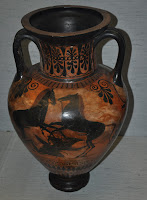The first annotation exercise was to annotate a Greek vase; via the Internet I identified that The Lady Lever Art Gallery had a number of Greek artifacts so I paid it a visit to undertake this exercise.(See Annotation Book)
As part of this developing blog I thought it would be useful to provide some basic information in respect of the gallery (link attached) together with some images linked to the first part of the course.
The gallery was commissioned by Lord Leverhulme (1851 - 1925). Leaving school at 16 he went to work in his fathers grocery shop. He saw an opportunity to produce and sell soap in individual blocks and being the entrepreneur he was, he went on to establish the firm Lever Brothers.
He was a forward thing man and was concerned for the welfare of his employees, building Port Sunlight, a village, providing high quality accommodation for his staff, together with a library and village hall.
As his fortune increased so he was able to purchase art works, which he wished to share with the public. The amount of art to be shared with the public soon out grew the 'gallaries' used, so the local library and Hulme hall, both located in Port Sunlight, became the temporary home for his collection.
He saw the need to build a purpose build venue for his art, and subsequently commissioned ,William and Sagar Owen from Warrington to design, what is now the Lady Lever Art Gallery.
Lord Leverhulme had travelled extensively in America and was influenced in his choice of design by American business men who had or were building art galleries in the 'classical style'.
 |
| The Lady Lever Art Gallery |
The foundation stone was laid on 25th March 1914 and the gallery was opened on 16th December 1922. This gallery was to house the best of his collection, and at his speech on the 25th March he reiterated his belief that art enriched individuals and communities, stating that 'art and the beautiful civilize and elevate because they enlighten and enoble' (Liverpool Museums web link)
The gallery contains work by;
- Reynolds
- Gainsborough
- Stubbs
- Turner
- Millias
- Burne-Jones
- Lord Leighton
- Rossetti
- Alma-Tadema
- Holman Hunt
- Waterhouse
An interesting aspect of the building design are the circular rooms built to hold various sculptures, see image below. The perimeter of the room has a number of busts on display but the center piece of this room is the statue of Antinous. This statue, carved after his death is based on a classical Greek prototype of the 5th Century.
As can be seen from the image, the roof is supported by a number of Ionic columns.
 |
| Antinous c130 - 138BC Marble |
I based my self in the room that contained a number of Greek artifacts, making sketches and notes for the annotation exercise (please see related books). There were a large number of items to chose from, and I focused on one that I thought I could more easily sketch, given what are my limited sketching skills.

I took photographs of some of the others items, and have incorporated them into this blog. One thing that I did find strange was a Wedgwood Basalt Vase on display in the same room, given the fact there is a room dedicated to Wedgwood.
I have incorporated an image of the vase and it can be seen that there is a direct correlation between the design of the original Greek Vases and this piece of Wedgwood, evidencing in part the impact of the 'classical canon' on 18th century design.
 |
| Apillian Red figure 3rd 1/4 of the 4th Cent. BC |
 |
| Attic Black Figure Last 1/4 of the 6th Cent BC |
 |
| Attic Black Figure Last 1/4 of the 6th Cent |
 |
| Wedgwood Basalt vase painted in 'Encaustic' colour 1780 - 1800 |
No comments:
Post a Comment